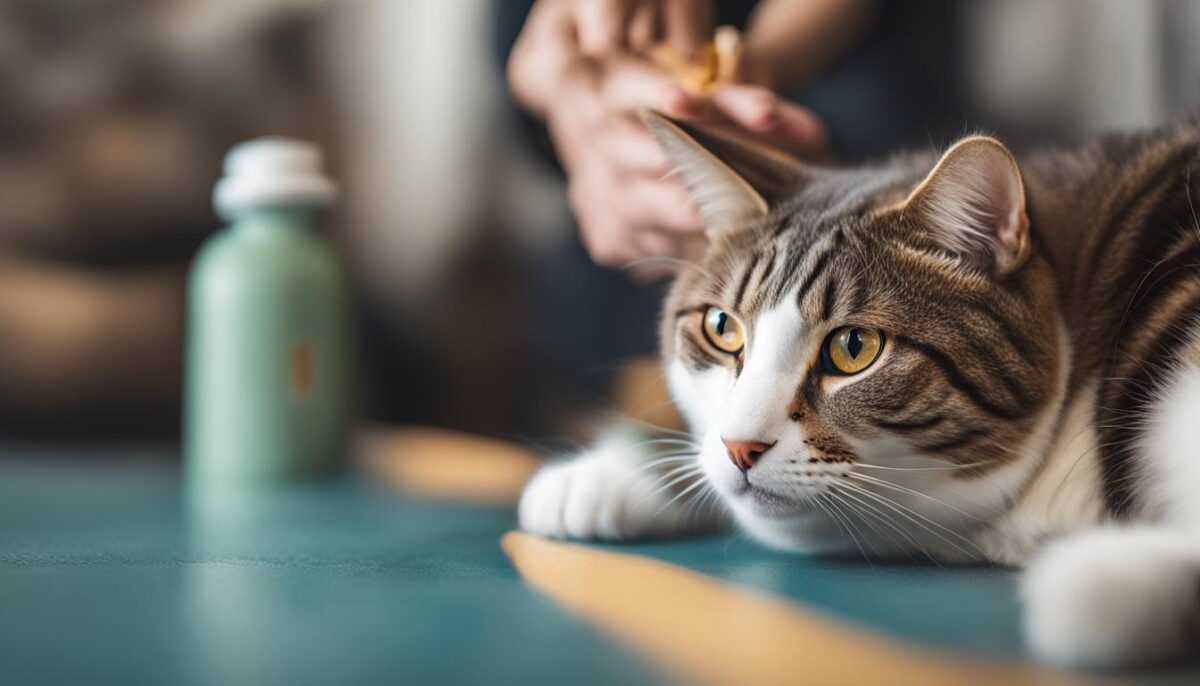Have you ever thought that your kitty could learn cool tricks just like dogs do? Well, guess what – they can! Your cat is super smart and with some yummy treats, fun playtime, and your love, they can learn to show off good manners. When you teach your cat, you both get closer and they feel happy too!
With cat training techniques and in-home cat behavior modification, you can help your cat understand what you like. It’s like teaching them the rules of a game where both of you win. So, let’s get started and turn training time into fun time!
Key Takeaways
- Cats can learn awesome things at home.
- Using treats, play, and cuddles works best.
- Training makes you and your cat better friends.
- Keep it fun and easy for the best learning.
- Teach them rules that make everyone happy.
Demystifying the Myths of Feline Independence
Have you heard that cats are too independent to listen to humans? That’s not the whole story! Cats may seem like they don’t need anyone, but they actually have smart ways of understanding the world. With patience and love, you can teach your cat new things.
Dispelling Common Misconceptions
It’s a big myth that cat intelligence means they only do what they want. In fact, cats can follow rules and make choices just like us. Just because cats enjoy their alone time doesn’t mean they don’t love being with their families.
Recognizing Feline Intelligence and Trainability
Cats are not only clever; they’re also quite able to learn new tricks. Ever seen a cat use a litter box? That’s because they’ve been trained! With the right steps, your cat can learn many new things. Feline independence doesn’t mean they can’t be trained; it just means they like to learn in their own unique way.
With understanding and gentle guidance, any cat can learn how to behave better. Using treats and cuddles, you can help your cat figure out how to be the best pet. So next time you think a cat can’t be trained, remember, with the right approach, they can achieve a lot!
Creating a Positive Learning Space for Your Cat
Did you know that your fluffy friend loves to learn in a cozy, feline-friendly environment? Yes, creating a special spot for your cat to learn is like giving them their own little classroom! You’ll need a place that’s quiet and has no things to distract them, like loud noises or other pets running around.
Think about when your cat is most awake and ready to play—like right after a good nap. That’s the perfect time for a short training session! Cats like things to be the same each day. It helps them learn. And remember, keep training fun with lots of positive reinforcement. It’s like giving your cat a gold star every time they do something great!
- Find a quiet spot just for your kitty’s learning time.
- Pick the right time when your cat is full of energy.
- Keep training short and sweet—they have little attention spans.
- Use the same words and treats to help them understand what you want.
Cats love routine, just like you might have a bedtime routine. So, making their learning part of their daily schedule makes them super students. And the tricks you teach? They could be simple things like coming when called or cute things like giving a high-five.
Set up a routine and be patient, as your kitty will take some time to learn new tricks with positive reinforcement.
Ready to create a wonderful cat learning space? Keep everything simple, clear, and fun. Your cat will love it, and you’ll be amazed at what they can learn!
Feline Behavior Training: The Basics
Hey there, cat lovers! Training your fluffball is easier than you think. You’ve got to understand how cat positive reinforcement works. It’s all about giving your kitty a high-five (with treats or pets!) for good behavior. This way, your fur-friend learns what you like and does it more. Let’s dive into the feline training basics and find out why being kind is the key!
What Is Positive Reinforcement?
Imagine getting a gold star every time you do something great—that’s positive reinforcement! For cats, it’s about getting a tasty treat or a loving cuddle when they do something good. Use a clicker or your happy voice to tell your cat, “Hey, you did awesome!” This helps your furry buddy to understand cat behavior and repeat the good stuff. Positive reinforcement makes training a fun game rather than a chore for your whiskered pal.
Why Punishment Doesn’t Work with Cats
Now, let’s talk about the no-nos. Yelling or scary noises don’t teach your cat what’s right. In fact, it just freaks them out and can hurt your friendship. Cats are smart, but they don’t link the scary stuff with what they did wrong. Stick to cuddles and treats instead, and watch as those purrs turn into the perfect behavior!
| Do This! | Not That! |
|---|---|
| Give treats for using the litter box | Never shout for missing the litter box |
| Use a clicker when they come when called | Avoid chasing them for not coming when called |
| Pet and praise for gentle play | Skip scolding for rough play |
Remember, training your cat takes patience and lots of love. Stay cool and keep the mood light. Before you know it, your cat will be the purr-fect buddy, all thanks to understanding and kindness!
Essentials of Everyday Cat Behavior Management
Managing how your cat acts every day is a big part of having a happy pet and a happy home. When your cat is acting in a friendly way, like not hiding or playing nice with other cats, it’s good to give them a treat. This shows them they’re doing a great job at being social.
Encouraging Social Behavior
If your cat is shy or scared, you can help them become more social. You do this by being kind when they come out to play or when they are cool with new people or pets. Each time they do good, a little reward can make them understand that being friendly is great!
Molding Good Petting Etiquette
Cats need to know how to be nice when you pet them. This means not biting or scratching. It helps stop them from getting mad or scared. When you touch your cat and they are calm and sweet, giving them a small treat tells them they are doing it right.
Redirecting Scratching to Appropriate Surfaces
Cats love to scratch. It’s just what they do! But we don’t want them scratching up couches or curtains. By giving them a scratching post and telling them “good job” when they use it, they learn where it’s okay to scratch. If they ever forget, just show them the scratching post and give them a treat when they use it.
FAQ
What are some effective cat training techniques I can use at home?
Positive reinforcement is one of the best techniques for in-home cat behavior modification. It involves rewarding your cat for desirable behaviors, such as treat provision, verbal praise, or playtime, to reinforce those actions. Consistent training sessions, attention to your cat’s active periods, and understanding their motivations are all crucial for successful training at home.
Is it a myth that cats are too independent to train?
Absolutely, it’s a myth! Cats can demonstrate a surprisingly high level of trainability and intelligence, they just need the right environment and motivation. By tapping into their instincts and interests, like their love for treats or affection, you can guide their behavior and strengthen your bond.
How can I create a feline-friendly environment that promotes learning?
To create a positive learning space for your cat, choose a quiet area without distractions and make sure to train during their naturally active times. Routine and predictability are key, so incorporating regular, short training sessions into your cat’s schedule can help them learn effectively. Remember, a predictable and comfortable environment can enhance your cat’s receptivity to training.
What is positive reinforcement in the context of cat training?
Positive reinforcement in cat training involves encouraging and rewarding desired behaviors to increase the likelihood of those behaviors being repeated. This can be achieved through treats, affection, or clicker training — where a clicker sound signals a reward. This method builds trust and cooperation, as your cat begins to associate good behaviors with positive outcomes.
Why doesn’t punishment work when training cats?
Cats do not associate punishment with their behavior, and negative actions like yelling or hitting can create fear and stress. This can damage the human-cat relationship and does not effectively teach or modify behavior. Positive reinforcement, on the other hand, helps cats understand what is expected without causing distress.
How can I encourage social behavior in my cat?
Reward your cat for social behaviors, such as coming out of hiding or being calm around other cats or visitors. You can use treats, play, or affection as rewards, consistently reinforcing the behavior you want to see. Over time, this will help your cat become more sociable and less fearful in social situations.
What can I do to mold good petting etiquette in my cat?
Teaching good petting etiquette is all about positive reinforcement. Start by petting your cat in areas they enjoy and reward them for remaining calm and gentle. Gradually introduce petting in other areas, always observing their comfort level. Rewarding them for good behavior during petting sessions will help establish proper etiquette.
How can I redirect my cat’s scratching to appropriate surfaces?
Provide your cat with scratching posts or pads in various locations around the house. Encourage their use by sprinkling catnip on them or dangling toys near the surface, and then reward your cat whenever they use the post instead of furniture. Consistency and patience are essential as your cat learns to redirect their scratching habits to appropriate surfaces.


